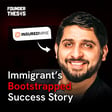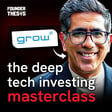
Understanding Private Credit, AIFs & Startup Financing | Vinod Murali (Alteria Capital)
"Venture debt is like an umbrella - you buy it before it starts raining, because once it starts raining, everything becomes expensive."
This analogy perfectly captures the strategic timing required for startup capital - smart founders raise debt when they don't need it, not when they're desperate.
Vinod Murali is the Co-founder and Managing Partner of Alteria Capital, India's largest venture debt fund managing ₹4,500 crores across multiple funds. Widely recognized as the pioneer of venture debt in India, he has over 17 years of experience in the space and has personally backed more than 220 startups including unicorns like Spinny, Rebel Foods, Country Delight, and OneCard. His firm has deployed over ₹7,500 crores to date, making him one of the most influential figures in Indian startup financing. Before founding Alteria, Vinod spent nearly a decade building India's first venture debt business at Silicon Valley Bank and later InnoVen Capital.
Key Insights:
👉Private Credit Evolution: Venture debt sits within the ₹2 trillion private credit ecosystem, filling the gap between traditional banking and equity financing
👉Indian Market Adaptation: India required a complete rewrite of the Silicon Valley venture debt model due to its execution-heavy versus IP-heavy nature
👉Risk Framework: Successful venture debt relies on evaluating four key risks - selection, performance, payment, and resolution
👉Capital Timing Strategy: The best time to raise debt is when you don't need it, not during crisis situations
👉Portfolio Performance: Alteria has achieved less than 0.5% losses across their ₹7,500 crore deployment
👉Regulatory Arbitrage: The shift from NBFC to AIF structure unlocked better capital access and tax efficiency for venture debt funds
#VentureDebt #StartupFunding #IndianStartups #PrivateCredit #StartupCapital #VentureCapital #AlteriaCapital #StartupAdvice #Entrepreneurship #StartupStrategy #VinodMurali #FounderThesis #AkshayDatt #StartupFinance #VentureFinancing #StartupEcosystem #BusinessStrategy #StartupGrowth #FinancialStrategy #startuppodcast
Disclaimer: The views expressed are those of the speaker, not necessarily the channel.



















